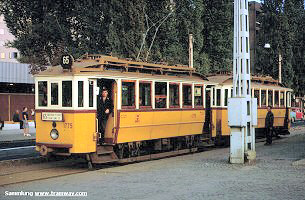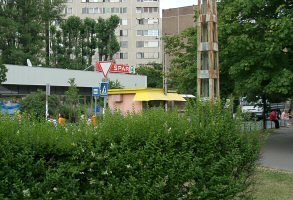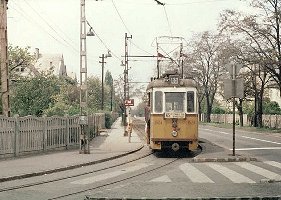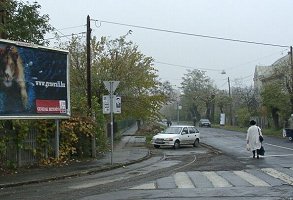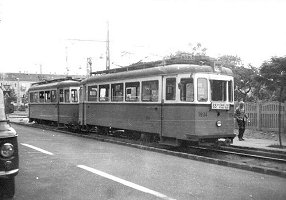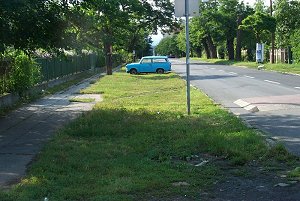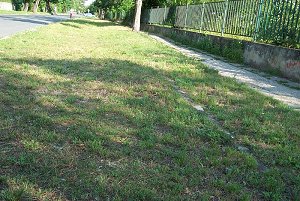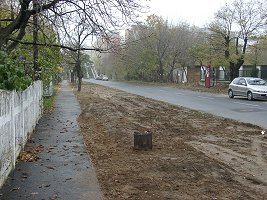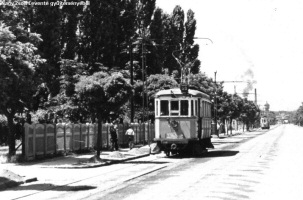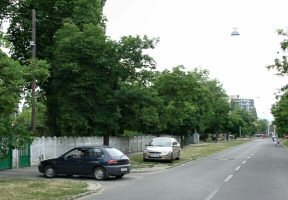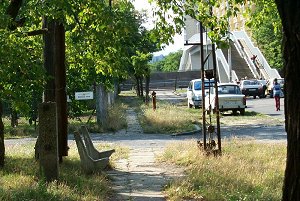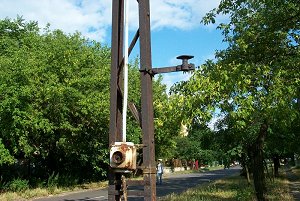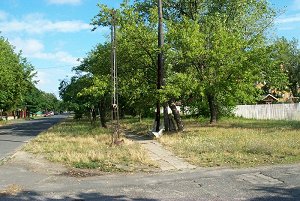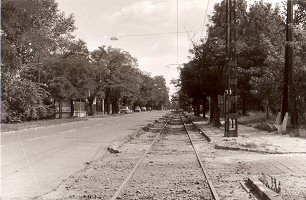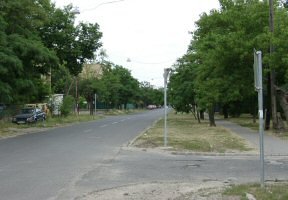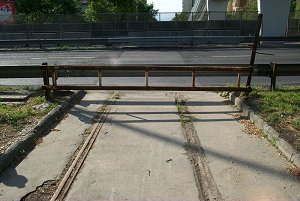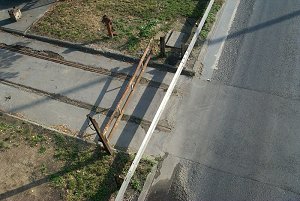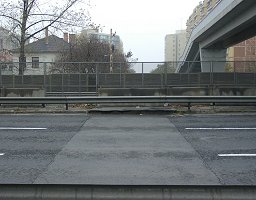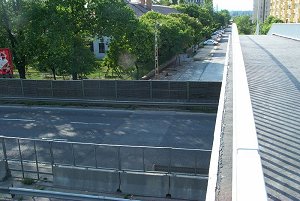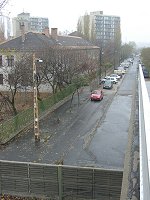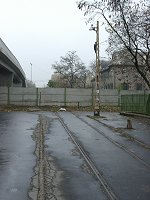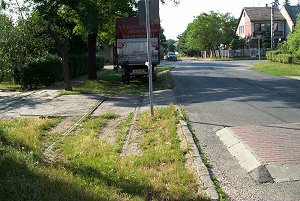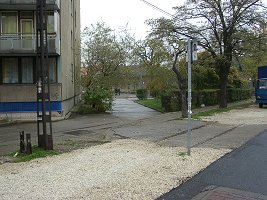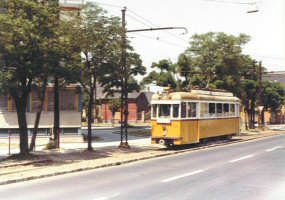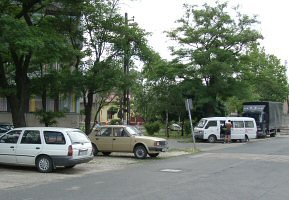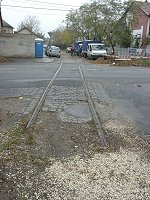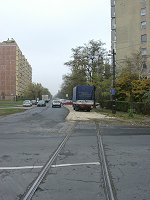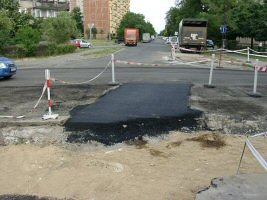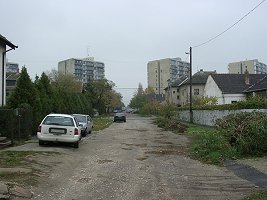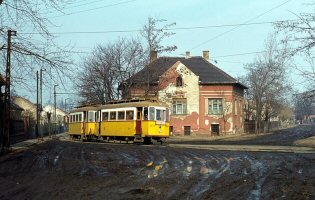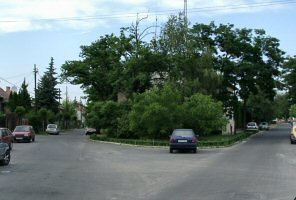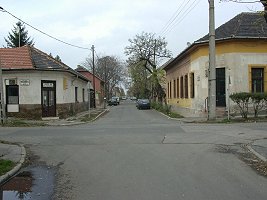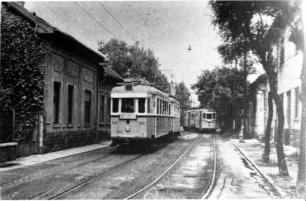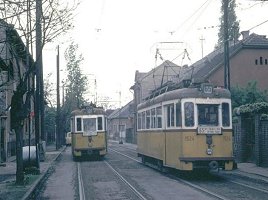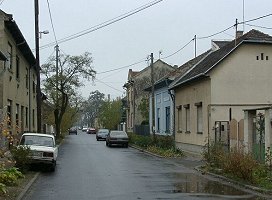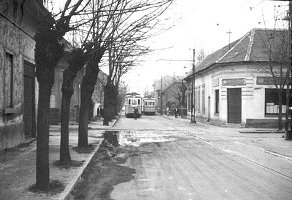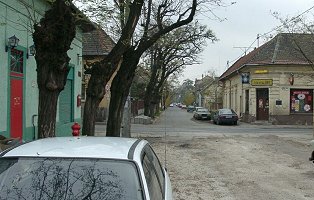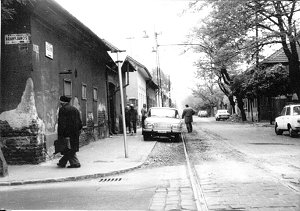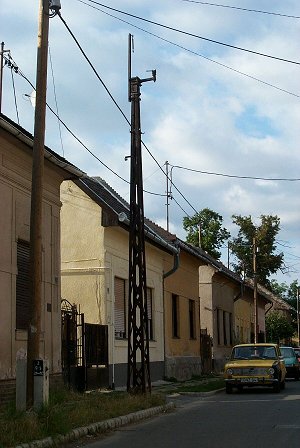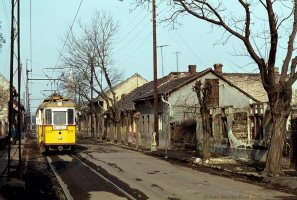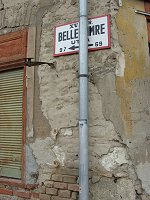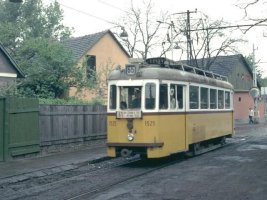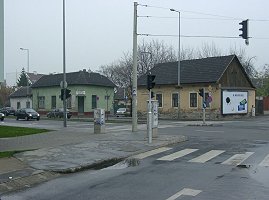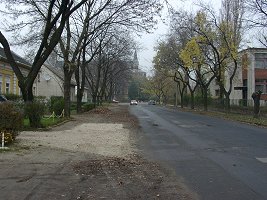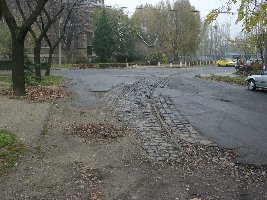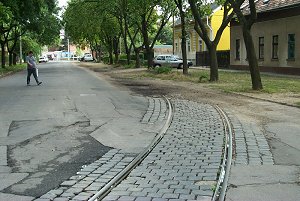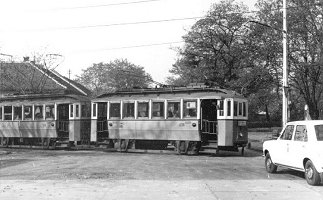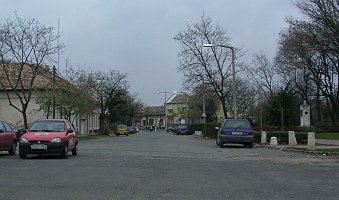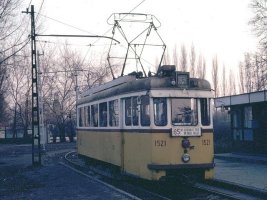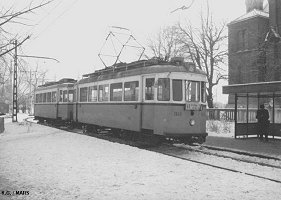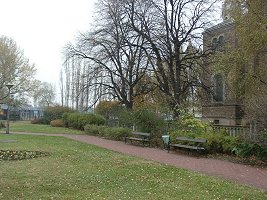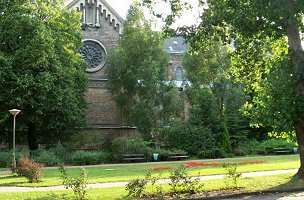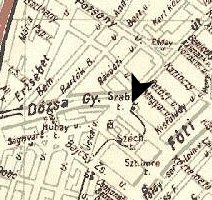budapest
other hungarian
close-up
lost rails
other countries
Rákospalota, MÁV telep (now Mézeskalács tér) - Czabán Samu tér (now Széchenyi tér)
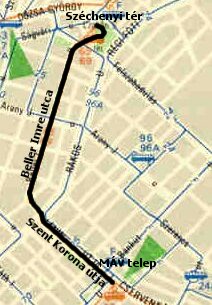 Route
65 is another one of the legendary "lost" tram lines: it's like
a myth among Budapest tram fans. This might seem strange at first sight,
because judging from its traffic network importance, it was just a low-traffic
single-track line running in an almost upcountry environment. It wasn't
a long one - you can see the last route of tram 65 marked with a thick
black line on a 1969 map to the left. And it wasn't even that long
ago when the last scheduled tram rolled over its rails. Where does this
mystic status come from, then?
Route
65 is another one of the legendary "lost" tram lines: it's like
a myth among Budapest tram fans. This might seem strange at first sight,
because judging from its traffic network importance, it was just a low-traffic
single-track line running in an almost upcountry environment. It wasn't
a long one - you can see the last route of tram 65 marked with a thick
black line on a 1969 map to the left. And it wasn't even that long
ago when the last scheduled tram rolled over its rails. Where does this
mystic status come from, then?
Most of the magic came of course because the trams were running in the kind of environment in which you'd never expect to see trams. Picture this: old houses with rustic gardens. Dogs barking, chicken chirping, roosters crowing, and the residents having a bit of chit-chat over the fence. And in the middle of this quiet community a tramcar stops at a passing loop. The driver gets off and feeds a stray dog while everyone waits for the tram coming from the opposite direction. He sees someone familiar and greets him with his name, because the tram driver knows most of the inhabitants by name. Sounds nice, ain't?
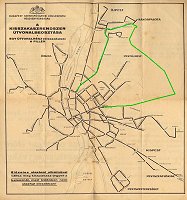 Of
course this tram line started out as something completely different in
1913 - as a two-track suburban railway line between the Újpest
HÉV service of BURV (which in reality wasn't a HÉV, but a tram going out
of Budapest, because Újpest wasn't part of the capital back then)
and the Rákosszentmihály / Gödöllő HÉV service. The
trains would start at Keleti pályaudvar (Budapest East railway
station), go all the way to Sashalom, then turn north-west into
Rákosszentmihály. After crossing some empty fields around where
now Újpalota is, the line entered Pestújhely (where
now MÁV telep and Mézeskalács tér are). From there it
would go over to Újpest via Rákospalota, Széchenyi tér,
and then return to Budapest over the tracks of what's now known as tram
route 14. The final destination was Nyugati
pályaudvar (Budapest
West railway station). The image to the right shows approximately
(very roughly, just to give a hint of how long it was!) the route of this
service with a green line. As it turned out, the route wasn't very popular
with long train succession times, so it was shortened on both ends: first
on the western end to Rákospalota, Széchenyi tér, and then on
the eastern to Sashalom. During World War II, one of the tracks
between Nádastó station and Rákospalota, Széchenyi tér
was removed because they'd need the rails elsewhere.
Of
course this tram line started out as something completely different in
1913 - as a two-track suburban railway line between the Újpest
HÉV service of BURV (which in reality wasn't a HÉV, but a tram going out
of Budapest, because Újpest wasn't part of the capital back then)
and the Rákosszentmihály / Gödöllő HÉV service. The
trains would start at Keleti pályaudvar (Budapest East railway
station), go all the way to Sashalom, then turn north-west into
Rákosszentmihály. After crossing some empty fields around where
now Újpalota is, the line entered Pestújhely (where
now MÁV telep and Mézeskalács tér are). From there it
would go over to Újpest via Rákospalota, Széchenyi tér,
and then return to Budapest over the tracks of what's now known as tram
route 14. The final destination was Nyugati
pályaudvar (Budapest
West railway station). The image to the right shows approximately
(very roughly, just to give a hint of how long it was!) the route of this
service with a green line. As it turned out, the route wasn't very popular
with long train succession times, so it was shortened on both ends: first
on the western end to Rákospalota, Széchenyi tér, and then on
the eastern to Sashalom. During World War II, one of the tracks
between Nádastó station and Rákospalota, Széchenyi tér
was removed because they'd need the rails elsewhere.
In 1952 the line was transferred to the Budapest tram company FVV, which separated it into sections. Between Keleti pályaudvar and Rákosszentmihály HÉV operation was left as it was, but between Rákosszentmihály, Csömöri út and Rákospalota, Széchenyi tér a tram service was started with the number 69 (it hasn't got anything to do with the current tram route 69). Route 65 was started as an additional service between Rákospalota, Széchenyi tér and Thököly út.
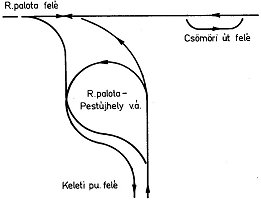
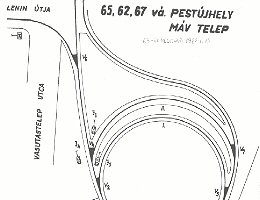
The track layout of Rákospalota, MÁV telep in
1970, and between '73 and '81
In 1970 both the Rákosszentmihály HÉV and tram route 69 were abandoned. Route 65 was also cut back to Pestújhely, MÁV telep, and so it remained until that sad January day in 1980, when the service was stopped. The main reason for the closure (apart from low utilization) was the new motorway M3 which was built literally right through Rákospalota. The single track of the line however was still left intact until 1984, because this was the only link between remise Zugló and remise Angyalföld - including a level crossing with the motorway! After 1984 the rails went waste...
Our walk through time and space begins at MÁV telep. Originally this neighbourhood was known as Pestújhely, but nowadays they call it Rákospalota, MÁV telep after the old housing estate of the state railways. To make things harder, BKV renamed its tram stop and terminus of route 62 here to Mézeskalács tér, so that's what you should look for on new maps. Anyway, if you face north besides the tracks of route 69, you can see a pair of "lost rails" in the asphalt. Yes, that's what's still there of route 65!
Tram 65 on the northern side of the square, somewhere between 1970 and 73, before the through tracks of today's route 69 were built.
After 1973, the terminus was located at the corner of Szent Korona útja, which was known as Lenin útja back then. Here you can see a lovely F1A car (1500-series) waiting for departure.
A 1900-series twin doing the same.
Another 1500er in front of the old housing estate of the hungarian state railways.
The former private right of way of the tram can still be seen. You can also spot some remainders of overhead support poles!
A picture from the fifties, and about the same spot today.
Until 2001 there was also this lost tram stop at the corner of Ozmán utca to be seen. Quite remarkable: the overhead support with the switch for the tram stop lights, the arm of the tram stop sign, the bench were there - it's so sad that all this dissapeared in 2002!
Rails still there and rails gone.
As we reach the M3 motorway, we can spot some very lost rails in the pavement!
The rails in the asphalt of the M3 motorway were there until the late nineties: cars bumped over them long after it was used for the last time! Now they're gone.
After the motorway we can see even more lost rails and overhead supports.
Today, loosely parked autos occupy the space that once belonged to the tram.
The crossing of Rákos utca, where a few meters of tram tracks survived until 2005.
The crossing in 1976 and now.
It's a bit hard to imagine how the two-track HÉV line ran here!
After two blocks the tram turned onto Beller Imre utca. As you can see on Alan Murray-Rust's old photo on the left-hand side, most of the streets around here lacked a proper pavement until the eighties.
This black&white photo by Tim Boric shows the classic small village character of Rákospalota.
Facing north the track ran on the left side of this not very broad street.
The passing loop (or bypass) at Szerencs utca with two 1900-series twins. (A twin is a two-car train with one car having one half of the equipment, and another having the other half. They cannot work separated - I'd say "siamese twins" would be a better name!)
Another picture taken by Tim Boric in 1976. The wooden-bodied 1700-series twin is waiting for the opposite tram, which can be seen in the distance.
The same spot from the other side with 1500-series solo cars, photoed by Heinz Heider. This passing loop was a bit strange, because trams used it by left-hand rules, rather than the normal right-hand way of going...
Another picture with two 1900-series twins.
You can guess the location of the missing track in the surface.
The crossing of Arany János utca: the old picture on the left was taken after the closure of the line, but the rails and catenary were still intact. The holding arm of the tram stop sign still sticks out of the wall even today!
Memento? The only remaining overhead support in Beller Imre utca!
Photos from the seventies, and another sign-holder arm sticking out of the wall at the crossing of Rädda Barnen utca.
At first sight you would not say that these two images were taken at the same spot, but they were! This is the crossing of Szőcs Áron utca/Szentmihályi út. As you can see, some old houses have fallen victim to the broadening of the street perpendicular to the tracks...
In the distance you can make out the contours of the parish church at Széchenyi tér (which was known as Czabán Samu tér for a while).
More lost rails!
The one-track path of the tram...
... went around the church...
... and led to the terminus Rákospalota, Széchenyi tér.
The terminus laid right beside the church - originally (in the "route 69"-days) the quarter-hour strike of the churchbell marked the departure of the trams!
Another view of a 1900-series twin from a different angle.
The single track did not end here: since the line also acted as a link between remises, it was connected to route 55 running on the north-eastern corner of the square. Until 1974, when latter route was running a different path - one street further to north -, the terminus was even located there, as you can see on the photo above (to help you locating the spot easier, I marked the view-point with an arrow - pointing to the direction the photographer was looking into - on the map).
Don't let the route number "69" fool you: as I already mentioned, at the time the photo was taken, route 65 was an insection service of route 69. If you take a closer look at the picture, you can recognize a single streetcar behind (in front, actually) the old-fashioned wooden-bodied twin set with just one current collector up - that single car (probably a 1600-series steel-frame-bodied tramcar) is on route 65.
The line was closed on January 13, 1980.
Current photos: Ákos Baracsy, Ákos Endre Varga
Sources of archive photos: Tim Boric, Friedrich Haselberger, Heinz Heider,
Rudolf Lakos, Harald Schachenhofer, András Szekács, Lajos Szőnyi + the
collections of Zsolt Levente Nagy, Zoltán Ádám Németh, tramway.com
and the author
Back to the top Back to the main page

